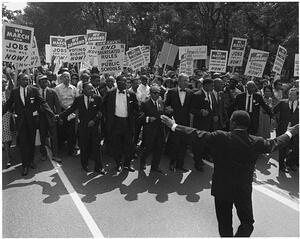Teaching Action and Understanding Justice
This January, the month where we honor Martin Luther King, Jr. and civil rights, our Rising Voices Fellows will be celebrating equality. Be sure to check the JWA blog each Tuesday for a new post from our fellows—and check out the great educational resources provided by our partner organization, Prozdor.
We were sitting in a circle, but the teacher spilt the class down the middle. Half received stickers, an apparent reward, while the other half sat and watched. No one knew exactly what was happening. We had always been told to work cohesively, so we recognized that the division was significant.
As we continued to listen, the teacher explained how the stickers were not a prize, but a symbol of difference. Now we could continue with our free time activities, but the sticker-students were restricted to the corner, with only materials falling apart at the seams. The students free of the bonds of stickers were welcome to play anywhere, but encouraged to stay away from those with stickers, and even act rudely if approached. This activity was often done in elementary schools to teach the concept of segregation to students.
I was first in the half without stickers, and felt the joy and freedom of being able to color with new markers, read new books, and play games without missing pieces. Twenty minutes later, we switched and suddenly I felt ashamed. An unexplainable anger built up inside my tiny nine-year-old self, but as a sticker-student I could not fight the injustice I felt. I sat and stewed as I put together a puzzle that lacked four pieces. It was the first time I had seen people persecuted for any reason. I had seen America as a symbol of liberty and justice for all, but the realities of segregation tainted the image.
It just did not make sense that certain people were punished, arrested, and even killed for having a skin color darker than mine. They simply had more melanin in their skin, which, in my mind, made them lucky; they were had more resistance to the horrible red burns I received from the sun each summer.
This entire scene took place in a brightly colored classroom more than seven years ago, but I remember it like it was yesterday. The schedule for the day read “Social Studies” under the allotted time slot and after the activity, we moved on. We never talked about having the power to fight social stigmas, and we didn’t really have any, back then. Nine-year-olds are still learning about the world.
I wish I could say that I now have the power. In less than a year I will be a legal adult, ready to vote and sign my own permission slips. But am I ready? Really?
I have heard the arguments that racism is over, everyone is equal, and on and on. But, the reality is that discrimination still exists. Today we see homophobia against people who are gay, and gay marriage. We see discrimination against people who have learning disabilities, against people who have a physical disability, against immigrants, women, and so many more.
Every day I see a new petition online urging me to stop using this word, or stand up for that cause. In reality, no matter how many I sign, or don’t, I am not affecting anything. Real change comes from dedicated people in face-to-face interactions with other people, politicians, and children. Instead of just teaching about these issues, we have to teach how to change them, too. That is the only way we will be able to create a world where no one is targeted for being different.
This piece was written as part of JWA’s Rising Voices Fellowship.







